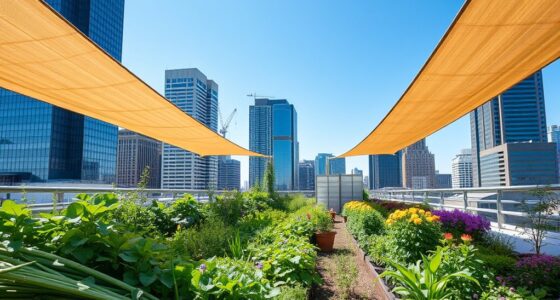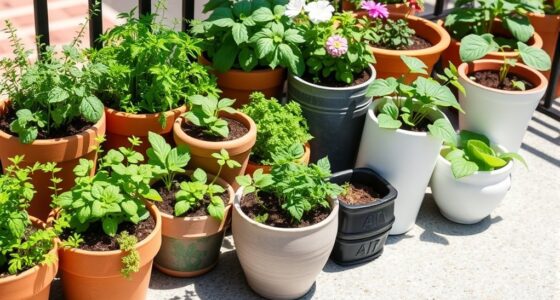Guerrilla gardening lets you transform abandoned lots into vibrant green spaces, often without official permission. You can choose neglected spots, clear debris, and improve the soil with compost or organic matter. Plant native plants that suit the local climate, requiring less water and maintenance. Your efforts support urban biodiversity, create habitats for pollinators, and foster community pride. Want to find out how small actions can make a big difference? Keep exploring for more tips.
Key Takeaways
- Identify neglected, accessible urban lots suitable for transformation into green spaces.
- Prepare soil by clearing debris, loosening compacted areas, and adding compost or organic matter.
- Plant native species adapted to local conditions for sustainable, low-maintenance greening.
- Use strategic planting and mulching to improve soil health, moisture retention, and plant establishment.
- Foster community involvement to promote ecological benefits and neighborhood pride through grassroots efforts.

Ever wondered how ordinary people transform neglected urban spaces into vibrant green areas? It’s a process driven by passion, creativity, and a desire to reclaim the city’s unused corners. Guerrilla gardening is all about taking the initiative to convert abandoned lots into lush, inviting spots, often without official permission. One of the key elements in this transformation involves understanding and working with urban soil. Unlike natural countryside land, urban soil is often compacted, contaminated, or lacking essential nutrients. Your goal is to improve its quality through simple methods like adding compost or organic matter, which can help native plantings thrive. Native plants are paramount because they’re adapted to the local climate and soil conditions. They require less water, fewer fertilizers, and are more resistant to pests, making your efforts sustainable and environmentally friendly. By choosing native plantings, you not only create a natural aesthetic but also support local ecosystems and wildlife.
When you start guerrilla gardening, you might focus on small patches, but the impact can be significant. Clearing debris and loosening compacted urban soil allows roots to penetrate more easily, encouraging healthy growth. You’ll want to select native grasses, wildflowers, shrubs, or ground covers that suit the specific conditions of the site. These plants often require minimal maintenance once established, which makes your initiative more effective and less labor-intensive over time. Planting directly into urban soil demands some preparation, but it’s a straightforward process. Dig small holes, incorporate compost or organic amendments, and carefully place your native plants. Mulching can help retain moisture, suppress weeds, and improve the soil’s health over time.
Guerrilla gardening also involves a keen eye for the right location and timing. You should look for spots that are visible and accessible but neglected—abandoned lots, empty patches, or overgrown corners. The goal is to create a space that invites community engagement and benefits the environment. Once established, native plantings can transform these areas into habitats for birds, pollinators, and insects, enriching urban biodiversity. Over time, your efforts can inspire others to take part, spreading awareness about the importance of sustainable urban greening. This grassroots approach not only beautifies the city but also fosters a sense of community ownership and pride, proving that even small actions can lead to big changes in neglected urban landscapes.
Frequently Asked Questions
Is Guerrilla Gardening Legal in All Areas?
You might wonder if guerrilla gardening is legal everywhere. It’s not—local regulations and property rights vary widely. In some areas, planting without permission can lead to fines or legal trouble. Before you start, check local laws and respect property rights. While your intentions may be positive, always seek permission when possible to avoid issues and help foster community support for your greening efforts.
What Are the Best Plants for Guerrilla Gardening?
Did you know that choosing the right plants can boost your guerrilla gardening success by over 50%? You should pick native wildflowers, which attract local pollinators, and drought-tolerant plants that survive tough conditions with less water. These plants are low-maintenance, eco-friendly, and thrive in abandoned lots. Your efforts will create vibrant, sustainable green spaces that benefit the community and support local ecosystems.
How Can I Prevent My Efforts From Being Removed?
To prevent your efforts from being removed, you should address legal concerns and property rights. You can do this by choosing public spaces where permission isn’t required, or by engaging with community groups and local authorities to gain support. Document your work to show positive impact, and consider planting native species that blend naturally. Respect property boundaries, and always be discreet to avoid conflicts or misunderstandings about your gardening activities.
What Tools Are Essential for Guerrilla Gardening?
Did you know urban soil often lacks nutrients, making planting tough? To succeed, you’ll need essential tools like a trowel, pruning shears, and gloves. These help you dig, plant, and maintain your guerrilla garden with ease. Focus on effective planting techniques, like proper soil preparation and layering, to guarantee your plants thrive. With these tools and methods, you’ll transform neglected spaces into lush, green retreats.
How Can Communities Support Guerrilla Gardening Initiatives?
You can support guerrilla gardening initiatives by fostering community engagement and building local partnerships. Volunteer your time, share resources, and spread awareness about the benefits of urban greening. Organize neighborhood events or collaborate with local organizations to create a collective effort. Your involvement inspires others to join, making a lasting impact. By working together, you help transform neglected spaces into vibrant, green areas that benefit everyone in your community.
Conclusion
By taking action like planting flowers in abandoned lots, you help transform neglected spaces into vibrant community areas. Imagine walking through a once-barren lot now bursting with colorful blooms, inviting neighbors to gather and reconnect. Your small effort can spark big change, turning forgotten places into green sanctuaries. So, get involved in guerrilla gardening—you’ll see how your quiet acts of rebellion can foster beauty, community, and hope right in your own neighborhood.









